If you have ever wondered💭 how to use a clicker for dog training? then welcome to the world of dog training.
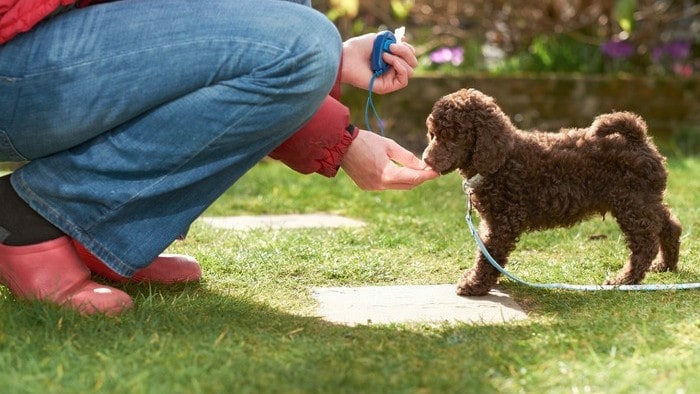
Picture this: you are in a noisy room filled with distractions, and your dog suddenly pays attention to your command and obeys without hesitation. Sounds like a scene from a sci-fi movie🎥, right?
Well, that’s the kind of magical obedience clicker training can bring into your life. So, if you’re tired of the endless “sit, sit, SIT!” repetitions, read on to learn the simple and effective ways of clicker training.
How to Use a Clicker for Dog Training?
Clicker training is a great way to teach dogs new tricks and commands. It works by using a special noise, the ‘click,’ along with a treat as a reward.🍖 The click is like giving your dog a thumbs-up at exactly the right moment when they do something you like.
Dogs may not understand our words very well, but they can easily learn to recognize the click as a sign that they did something good. It’s like saying, “Yes, that’s right!”🎉 in a language your dog understands. With practice, your dog gets better at connecting the action you want with the reward they like.
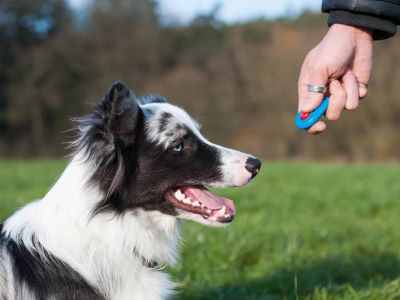
In a nutshell, clicker training helps you communicate closely with your dog, making training fun and effective. It’s like having a secret language that helps your dog to learn and follow your commands[1]. Now let’s see how clicker training works:
Preparing for Clicker Training
Here are some Materials you will need:
Clicker🎚️
Dog leash (optional)
Treats🍖
Choose a quiet and distraction-free environment
Implementing Clicker Training
When beginning clicker training, it’s essential to start with straightforward commands. By starting with these simple commands, you build a solid foundation for more complex behaviours down the road.🛣️ Here are some of them:
- Sit: This is a fundamental command that many dogs learn first. It’s a great way to teach your dog self-control and attentiveness.
- Stay: Teaching your dog to stay in one place until you release them is crucial for safety and obedience.
- Come: The recall command, “come,” is vital for getting your dog to return to you when called, which is especially important in potentially dangerous situations.
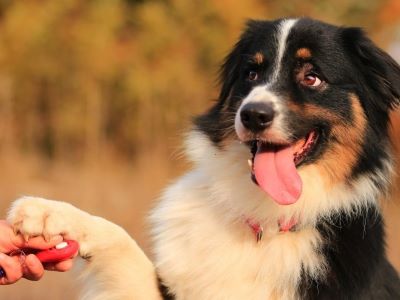
“The heart of clicker training lies in precise timing.⏱ When your dog performs the desired behaviour, such as sitting when you say “sit, “immediately press the clicker“, says the experts at PetMD.
The click should be followed by a treat within a second or two. The click serves as a clear and instant marker, telling your dog, “That’s what I want!”
Tip: Understand that learning takes time. Your dog may not get it right away, but with repetition and positive reinforcement, they will improve.📈 Keep training sessions short and frequent, usually around 10-15 minutes, to maintain your dog’s focus and enthusiasm.
Advanced Clicker Training
Clicker training can be a powerful tool for addressing and modifying unwanted behaviours, Let’s see how you can advance this journey:
1. Proofing Behaviours
After your dog has mastered the basics, it’s time to take their training to the next level by “proofing” their behaviours. Begin by practising in different locations, both indoors and outdoors. This diversity helps your dog generalize their learning, making it clear that the commands apply everywhere.
As you progress, gradually introduce distractions into your training sessions. Start with milder distractions and then slowly increase the level of difficulty over time.⏳
To truly solidify your dog’s training, try practising commands at different times of the day. This variation helps your dog become reliable, regardless of the situation or when the command is given.
Remember, it’s also beneficial to mix up the rewards you offer during training. Sometimes use praise, engage in play, or offer different types of treats.🍬🍭
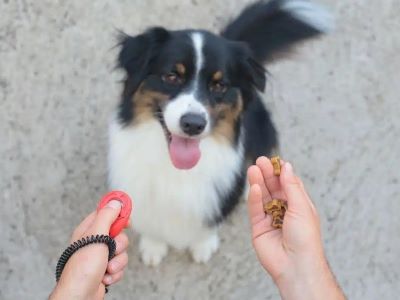
2. Shaping Complex Behaviours
Shaping involves breaking down a behaviour into smaller steps and rewarding your dog’s progress toward the final behaviour[2]. Choose a behaviour you want to teach, like rolling over or fetching a specific item.
Break down the behaviour into small, manageable steps. For example, for “roll over,” the steps might include lying down, turning the head, shifting the shoulders, and completing the full roll.🍥
Once your dog masters individual steps, start combining them until your dog can perform the complete behaviour. Shaping complex behaviours enhances your dog’s problem-solving skills.
3. Addressing Behaviour Problems
Clicker training isn’t just for teaching new behaviours; it’s also for fixing unwanted ones. Pinpoint the specific behaviour problem, whether it’s excessive barking, jumping on guests, or leash pulling.
Figure out what’s causing the unwanted behaviour. Is it fear, anxiety, excitement, or a lack of training? Develop a plan that focuses on teaching an alternative behaviour. For instance, if your dog jumps on guests, teach them to sit instead.🪑
Make sure everyone in your household follows the same training plan and enforces consistent rules. If the problem persists or is severe, consider consulting a professional dog trainer or behaviourist for specialized guidance.
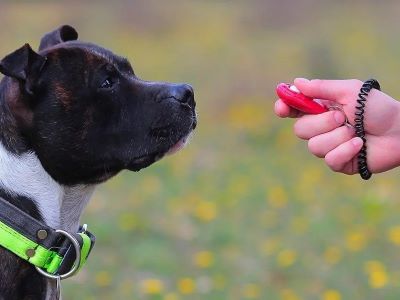
Troubleshooting Tips
Troubleshooting⚠️ these common issues will help you and your dog have a smoother and more effective clicker training experience. Let’s see some of them:
- Over-Clicking: Be precise in your timing. Click only when your dog performs the desired behaviour.
- Under-clicking: Clicking too infrequently may cause your dog to lose interest. Ensure you click immediately when your dog gets it right.✅
- Timing Errors: Timing is critical for your dog to associate the click with the correct action.
- Fading the Clicker: Gradually reduce the frequency of clicks as your dog becomes more skilled. Transition to occasional clicks and rewards while maintaining consistency in expectations.
- Handling a Shy Dog: Some dogs may initially find the clicker sound startling. To help them adapt, start with softer clicks or muffled clicks through a towel. Gradually increase the volume as your dog becomes comfortable.
Consistency is the key🔑 of successful training! Ensure that everyone involved in your dog's training follows the same commands, cues, and reward systems.
FAQs
Is a Clicker Good for Dog Training?
It can reinforce behaviors in dogs and maintain their interest throughout a training session thanks to the reward system. With clicker training for dogs, dogs stay confident and happy throughout training. This makes them willing to try new things without fear of failure.
How to Use a Clicker for Dog Training?
Once you can see that your dog is anticipating the food when they hear the click, you can start introducing the clicker to mark good behaviour. Ask your dog to do something simple that they already know, such as ‘sit’ or ‘down’. As soon your dog sits, click and reward them.
Can You Train a Puppy With a Clicker?
The idea behind clicker training is quite simple: as your puppy is learning a new skill, the sound of the clicker allows you to ‘mark’ or pinpoint the exact moment when they’ve done a behaviour you like, and then you promptly deliver a treat to reward them for that behaviour.
Summary
In summary, we’ve explored the world of dog training using a clicker, turning your dog into a clever learner! So, how do you use a clicker for dog training? 🎓
It’s as simple as clicking, giving treats, and making everyday moments into fun training sessions. Think of the clicker as your special tool to talk to your dog.
You click when they do something right, and they get yummy treats. It’s like a secret code between you and your furry friend. So, get ready for a fun journey of bonding, training, and lots of happy moments with your dog. Start clicking! 🐶
Reference:
- Cpdt, S. G. M. (2023). How to use Clicker training to communicate with your dog. | American Kennel Club.
- Wikipedia contributors. (2023a). Clicker training. | Wikipedia.



